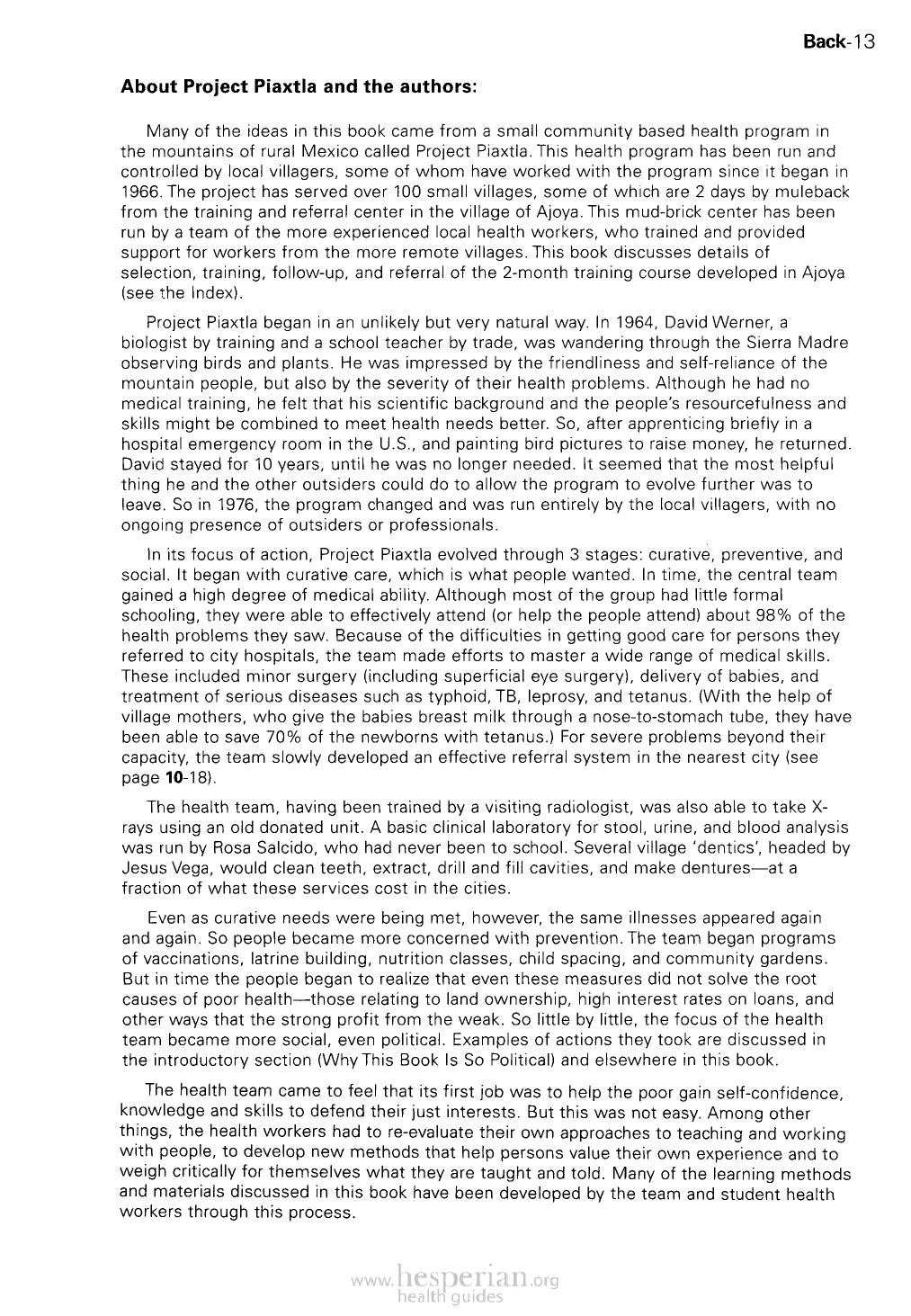
About Project Piaxtla and the authors:
Many of the ideas in this book came from a small community based health program in
the mountains of rural Mexico called Project Piaxtla. This health program has been run and
controlled by local villagers, some of whom have worked with the program since it began in
1966. The project has served over 100 small villages, some of which are 2 days by muleback
from the training and referral center in the village of Ajoya.This mud-bnck center has been
run by a team of the more experienced local health workers, who trained and provided
support for workers from the more remote villages. This book discusses details of selection,
training, follow-up, and referral of the 2-month training course developed in Ajoya (see the
Index).
Project Piaxtla began in an unlikely but very natural way. In 1964, David Werner, a
biologist by training and a school teacher by trade, was wandering through the Sierra Madre
observing birds and plants. He was impressed by the friendliness and self-reliance of the
mountain people, but also by the severity of their health problems. Although he had no
medical training, he felt that his scientific background and the people’s resourcefulness and
skills might be combined to meet health needs better. So, after apprenticing briefly in a
hospital emergency room in the U.S., and painting bird pictures to raise money, he returned.
David stayed for 10 years, until he was no longer needed. It seemed that the most helpful
thing he and the other outsiders could do to allow the program to evolve further was to
leave. So in 1976, the program changed and was run entirely by the local villagers, with no
ongoing presence of outsiders or professionals.
In its focus of action. Project Piaxtla evolved through 3 stages: curative, preventive,
and social. It began with curative care, which is what people wanted. In time, the central
team gained a high degree of medical ability. Although most of the group had little formal
schooling, they were able to effectively attend (or help the people attend) about 98% of the
health problems they saw. Because of the difficulties in getting good care for persons they
referred to city hospitals, the team made efforts to master a wide range of medical skills.
These included minor surgery (including superficial eye surgery), delivery of babies, and
treatment of serious diseases such as typhoid, TB, leprosy, and tetanus. (With the help of
village mothers, who give the babies breast milk through a nose-to-stomach tube, they have
been able to save 70% of the newborns with tetanus.) For severe problems beyond their
capacity, the team slowly developed an effective referral system in the nearest city (see
page 10-18).
The health team, having been trained by a visiting radiologist, was also able to take X-rays
using an old donated unit. A basic clinical laboratory for stool, urine, and blood analysis
was run by Rosa Salcido, who had never been to school. Several village ‘dentics’, headed
by Jesus Vega, would clean teeth, extract, drill and fill cavities, and make dentures—at a
fraction of what these services cost in the cities.
Even as curative needs were being met, however, the same illnesses appeared again and
again. So people became more concerned with prevention. The team began programs of
vaccinations, latrine building, nutrition classes, child spacing, and community gardens. But in
time the people began to realize that even these measures did not solve the root causes of
poor health—those relating to land ownership, high interest rates on loans, and other ways
that the strong profit from the weak. So little by little, the focus of the health team became
more social, even political. Examples of actions they took are discussed in the introductory
section (WhyThis Book Is So Political) and elsewhere in this book.
The health team came to feel that its first job was to help the poor gain self-confidence,
knowledge and skills to defend their just interests. But this was not easy. Among other
things, the health workers had to re-evaluate their own approaches to teaching and working
with people, to develop new methods that help persons value their own experience and to
weigh critically for themselves what they are taught and told. Many of the learning methods
and materials discussed in this book have been developed by the team and student health
workers through this process.